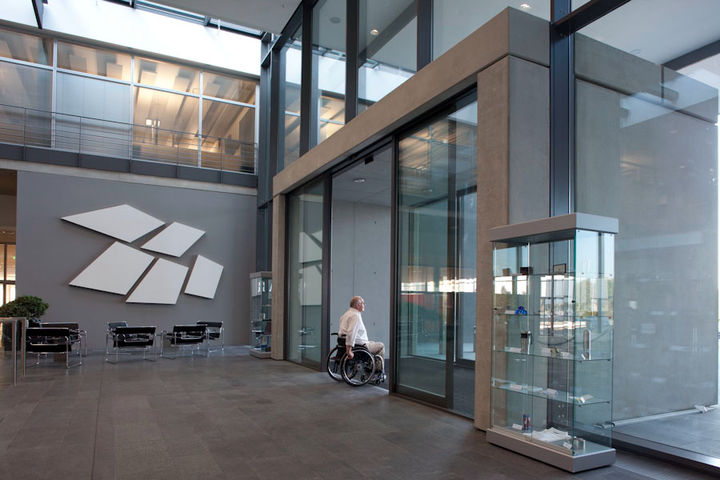DIN 18040: New requirements for barrier-free building through DIN EN 17210
The introduction of the European DIN EN 17210 standard in August 2021 necessitates a comprehensive revision of the German standard DIN 18040 for barrier-free building in order to harmonise the national standard with the new European standards. What changes are planned and how will they affect practical applications? Nadine Metlitzky and Günther Weizenhöfer, who are working together on the revision as part of the DIN NABau committee, provided exclusive insights into the current status and future development of DIN 18040 in an interview in the Deutsches Architektenblatt. The key findings from the interview are summarised here to provide an overview of the planned changes and their impact in practice.
Accessibility experts

GEZE expert and architect, Günther Weizenhöfer, helps us understand how DIN 18040 will be changing in the future. © Karin Fiedler / GEZE GmbH

Nadine Metlitzky is an architect, publicly-appointed and sworn expert for barrier-free building, in addition to being a consultant at the Institute for Federal Real Estate. © Metlitzky
Günther Weizenhöfer
GEZE expert and architect, Günther Weizenhöfer, is not only a specialist planner for preventive fire protection (TÜV) and team leader in the Sales Excellence division at GEZE, but also co-author of “Atlas barrier-free building”, having worked alongside the author and co-editor, Nadine Metlitzky.
Nadine Metlitzky
Architect Nadine Metlitzky is also a publicly-appointed and sworn expert for barrier-free building and a consultant at the Institute for Federal Real Estate. The two architects are active in the DIN committee NABau (DIN 18040) and in the VDI technical committee for accessibility – making them the perfect contacts to answer questions related to DIN 18040 and the new requirements for barrier-free building in DIN EN 17210.
Background and objectives of DIN EN 17210 for accessibility
DIN EN 17210 "Accessibility and usability of the built environment – Functional requirements" is the first comprehensive European standard on accessibility. For many countries in the European Union, this set of rules is the first and, therefore, only standard on accessibility, and has been introduced as a national regulation when it was published. In Germany, on the other hand, there have been established regulations and standards such as DIN 18040 for decades – which now need to be harmonised with the European DIN EN 17210.
Challenges of harmonising DIN 18040 for barrier-free building with DIN EN 17210
The harmonisation of DIN 18040 with DIN EN 17210 poses a number of challenges. In the DAB interview, Nadine Metlitzky and Günther Weizenhöfer explain that, in order to ensure the legal applicability of DIN 18040 in the future, a complete adoption of DIN EN 17210 at the national level was not considered. Therefore, the national standard is being revised to eliminate existing inconsistencies. This process is particularly complex, as the DIN EN 17210 standard covers areas that are regulated elsewhere in Germany, such as occupational health and safety, as well as accessibility.
An example: Changes to DIN 18040 in relation to doors
Some significant adjustments in the draft standard relate to structural requirements.
In concrete terms, this means the following when it comes to doors:
- The permissible height difference in the floor covering below the door leaf is reduced from two to one centimetre.
- Thresholds must be bevelled or rounded.
- The door handle height is extended to a range between 85 and 105 centimetres.
- The permissible operating forces on self-locking doors are formulated more clearly so that they take the needs of people with disabilities into account.
Adjustments for accessible fire protection
Evacuation strategies that are based solely on organisational measures are neither up-to-date nor sustainable, as they result in disadvantages for certain user groups due to their disability. The "Alerting and evacuation" section emphasises the need for accessible mobility chains that ensure continuous escape and rescue options for people with reduced mobility.
The integration of the building automation system is also becoming increasingly important, especially to support self-rescue in the event of a fire. Automated fire protection doors can save lives during such emergencies.
LEARN MORE ABOUT ACCESSIBLE FIRE PROTECTION DOORS
Possible influences of the new DIN 18040 on building planning
Nadine Metlitzky and Günther Weizenhöfer's preliminary conclusion: Overall, accessibility will take on a central role in building planning in the future and become a standard for modern, inclusive building. Accessibility is seen as a natural part of building planning and is no longer treated as additional work.
More information on the topic of "Barrier-free building – what changes will the new DIN 18040 bring?" is available in the German Architects' Journal (Deutsches Architektenblatt)
You can find the full interview with additional information in the Deutsches Architektenblatt DAB. There, Günther Weizenhöfer and Nadine Metlitzky explain in detail the challenges and progress made in harmonising accessibility standards, and give an outlook on what changes can be expected in the future – and when.
It is a must-read for anyone involved in inclusive building!
TO THE INTERVIEW AT DAB ONLINEGEZE: Your contact for specialist planning
Are you looking for a customised solution for your project? GEZE supports specialist planners and architects in all project phases and offers comprehensive project advice on all specifications, solutions and support services.
Contact our GEZE experts via the architects hotline: +49-7152-203-112



